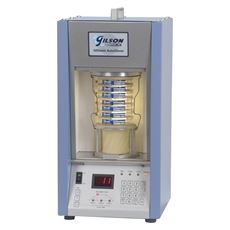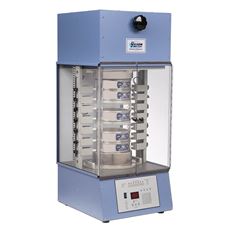- Log in
- Favorites List
-
Shopping Cart
You have no items in your shopping cart.
Sonic Sifters
Sonic Sifters use acoustic energy to create a vertical column of air for continuous agitation and add vertical or alternating vertical/horizontal tapping to assist in deagglomerating samples with hygroscopic, electrostatic or other adhesion issues.

Acoustic/tapping agitation provides rapid sample separation with minimal cloth wear. 3,600 sonic energy pulses per minute oscillate an air column through the sieve apertures of up to seven 3in or 8in (203mm) full-height sieves for sizing of small samples with particle sizes down to 5µm.
An internal microprocessor provides precise control of the oscillation amplitude and a ten program memory accommodates materials with different densities/textures and ensures repeatable results. Each program memory has three timed segments consisting of ramp-up time to desired maximum amplitude, maximum amplitude hold time, and ramp-down to zero amplitude. Tapping duration and positioning are also user-defined.
The Sonic Sifter sieving action, which can be varied for different densities and textures of material, is unique. A vertical column of air is created to oscillate through a sieve or set of sieves. The motion of the air alternately lifts the sample and then assists it through the sieve apertures. The oscillation amplitude is variable.
A vertical mechanical pulse may also be applied to the sieves at regular intervals to break down any clustered particles and help eliminate any blinding of the apertures.
An important feature of the Sonic Sifter is that it causes very little attrition of the sample and virtually no screen wear.
For more information, read our blog Sonic Sieving: The Solution for Particle Sizing Problems.
- GilSonic AutoSiever Sonic Sifter is the most accurate and reliable unit available for particle sizing of dry powders and fine granular materials with size ranges from No. 20 (850µm) to 5µm. Gilson 3in Acrylic Frame Sieves can be fitted with ASTM E11 woven wire cloth, or Precision Electroformed Mesh and are equipped with programmable vertical and horizontal tapping. Memory can store up to ten profiles with variable energy levels and ramp-dwell times.
- GilSonic UltraSiever® Sonic Sifter accepts up to seven full-height 8in (203mm) diameter test sieves and delivers accurate separations for fine samples up to 100g. Standard 8in ASTM Test Sieves or 8in ASTM Precision Electroformed Sieves may be used. Stores up to ten testing profiles in memory with different energy levels and test times.























